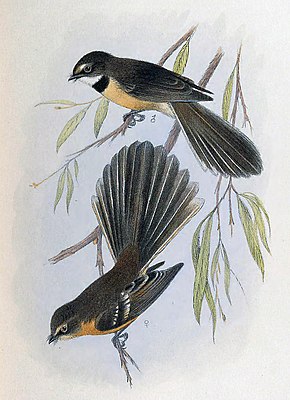Lord Howe gray fan tail
| Lord Howe gray fan tail | ||||||||||||
|---|---|---|---|---|---|---|---|---|---|---|---|---|

Lord Howe gray fan tail, below |
||||||||||||
| Systematics | ||||||||||||
|
||||||||||||
| Scientific name | ||||||||||||
| Rhipidura fuliginosa cervina | ||||||||||||
| Ramsay , 1879 |
The Lord Howe gray fan tail ( Rhipidura fuliginosa cervina ), also known as the Lord Howe gray fan flycatcher , is an extinct subspecies of the New Zealand fan tail . It was endemic to Lord Howe Island .
description
The Lord Howe gray fan tail reached a length of 12.7 centimeters. The head and neck were gray-black. There was a white spot above the ear. The back and the wing covers were black with a reddish brown tinge. The wings were dark brown and had two white bands. The eye stripe, throat and underside were light cinnamon brown. The iris was dark brown, the beak was black. There was no upper chest band as in the nominate form. The long, round tail was dark gray brown and could be spread like a fan. The outer tail feathers had narrow white seams.
Way of life
The Lord Howe gray fan tail inhabited open forests. Its diet consisted of insects that were captured in flight. A nest was discovered in a prickly bush in 1907 by the Australian naturalist Arthur Francis Basset Hull. Hull described the nest as wine-glass-shaped with an implied tail-shaped extension. The clutch consisted of two shiny, creamy white eggs with light brown spots and lines. The Lord Howe gray fan tail was a very trusting bird that even flew into the kitchens of dwellings to catch flies from the walls.
die out
In June 1918 the SS Makambo ran aground on a sandbank off Lord Howe Island. The escaping ship rats overran the island and wreaked havoc on the endemic bird life. The rats climbed the trees and ate the eggs and chicks. In 1924 the Lord Howe gray fan tail was considered extinct.
literature
- David Day: The Doomsday Book of Animals. Ebury Press, London 1981. ISBN 0670279870
- James Greenway: Extinct and Vanishing Birds of the World. Dover Publications Inc. New York 1967. ISBN 0-486-21869-4
- Dieter Luther: The extinct birds of the world. Westarp Sciences, 1986. ISBN 3-89432-213-6
- Walton Beacham: World Wildlife Fund Guide to Extinct Species of Modern Times , 1997. ISBN 0933833407